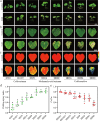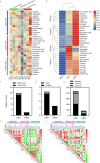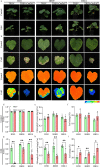Identification of candidate genes that regulate the trade-off between seedling cold tolerance and fruit quality in melon (Cucumis melo L.)
- PMID: 37416729
- PMCID: PMC10321389
- DOI: 10.1093/hr/uhad093
Identification of candidate genes that regulate the trade-off between seedling cold tolerance and fruit quality in melon (Cucumis melo L.)
Abstract
Trade-offs between survival and growth are widely observed in plants. Melon is an annual, trailing herb that produces economically valuable fruits that are traditionally cultivated in early spring in China. Melon seedlings are sensitive to low temperatures, and thus usually suffer from cold stress during the early growth period. However, little is known about the mechanism behind the trade-offs between seedling cold tolerance and fruit quality in melon. In this study, a total of 31 primary metabolites were detected from the mature fruits of eight melon lines that differ with respect to seedling cold tolerance; these included 12 amino acids, 10 organic acids, and 9 soluble sugars. Our results showed that concentrations of most of the primary metabolites in the cold-resistant melons were generally lower than in the cold-sensitive melons; the greatest difference in metabolite levels was observed between the cold-resistant line H581 and the moderately cold-resistant line HH09. The metabolite and transcriptome data for these two lines were then subjected to weighted correlation network analysis, resulting in the identification of five key candidate genes underlying the balancing between seedling cold tolerance and fruit quality. Among these genes, CmEAF7 might play multiple roles in regulating chloroplast development, photosynthesis, and the ABA pathway. Furthermore, multi-method functional analysis showed that CmEAF7 can certainly improve both seedling cold tolerance and fruit quality in melon. Our study identified an agriculturally important gene, CmEAF7, and provides a new insight into breeding methods to develop melon cultivars with seedling cold tolerance and high fruit quality.
© The Author(s) 2023. Published by Oxford University Press on behalf of Nanjing Agricultural University.
Conflict of interest statement
The authors declare that they have no known competing financial interests or personal relationships that could have appeared to influence the outcome of the research reported in this paper.
Figures








Similar articles
-
Exogenous glucose irrigation alleviates cold stress by regulating soluble sugars, ABA and photosynthesis in melon seedlings.Plant Physiol Biochem. 2024 Dec;217:109214. doi: 10.1016/j.plaphy.2024.109214. Epub 2024 Oct 19. Plant Physiol Biochem. 2024. PMID: 39454537
-
Dissecting the Genetic Architecture of Melon Chilling Tolerance at the Seedling Stage by Association Mapping and Identification of the Elite Alleles.Front Plant Sci. 2018 Oct 31;9:1577. doi: 10.3389/fpls.2018.01577. eCollection 2018. Front Plant Sci. 2018. PMID: 30429864 Free PMC article.
-
Abscisic acid and putrescine synergistically regulate the cold tolerance of melon seedlings.Plant Physiol Biochem. 2021 Sep;166:1054-1064. doi: 10.1016/j.plaphy.2021.07.011. Epub 2021 Jul 13. Plant Physiol Biochem. 2021. PMID: 34293605
-
Melon fruits: genetic diversity, physiology, and biotechnology features.Crit Rev Biotechnol. 2008;28(1):13-55. doi: 10.1080/07388550801891111. Crit Rev Biotechnol. 2008. PMID: 18322855 Review.
-
Overview of research on virus-resistant breeding of melon.Front Plant Sci. 2024 Dec 12;15:1500246. doi: 10.3389/fpls.2024.1500246. eCollection 2024. Front Plant Sci. 2024. PMID: 39726431 Free PMC article. Review.
Cited by
-
Map-based cloning revealed BhAPRR2 gene regulating the black peel formation of mature fruit in wax gourd (Benincasa hispida).Theor Appl Genet. 2024 Dec 10;138(1):3. doi: 10.1007/s00122-024-04796-6. Theor Appl Genet. 2024. PMID: 39658692
-
Molecular Markers for Marker-Assisted Breeding for Biotic and Abiotic Stress in Melon (Cucumis melo L.): A Review.Int J Mol Sci. 2024 Jun 7;25(12):6307. doi: 10.3390/ijms25126307. Int J Mol Sci. 2024. PMID: 38928017 Free PMC article. Review.
-
MicroRNA Profiling Revealed the Mechanism of Enhanced Cold Resistance by Grafting in Melon (Cucumis melo L.).Plants (Basel). 2024 Apr 2;13(7):1016. doi: 10.3390/plants13071016. Plants (Basel). 2024. PMID: 38611545 Free PMC article.
-
A natural variation in SlSCaBP8 promoter contributes to the loss of saline-alkaline tolerance during tomato improvement.Hortic Res. 2024 Feb 23;11(4):uhae055. doi: 10.1093/hr/uhae055. eCollection 2024 Apr. Hortic Res. 2024. PMID: 38659442 Free PMC article.
-
Physiological, transcriptomic, and metabolomic analyses of the chilling stress response in two melon (Cucumis melo L.) genotypes.BMC Plant Biol. 2024 Nov 14;24(1):1074. doi: 10.1186/s12870-024-05773-3. BMC Plant Biol. 2024. PMID: 39538130 Free PMC article.
References
-
- Zust T, Agrawal AA. Trade-offs between plant growth and defense against insect herbivory: an emerging mechanistic synthesis. Annu Rev Plant Biol. 2017;68:513–34. - PubMed
-
- Ding YL, Yang SH. Surviving and thriving: how plants perceive and respond to temperature stress. Dev Cell. 2022;57:947–58. - PubMed
-
- Goto S, Sasakura-Shimoda F, Suetsugu Met al. . Development of disease-resistant rice by optimized expression of WRKY45. Plant Biotechnol J. 2015;13:753–65. - PubMed
-
- Cerrudo I, Caliri-Ortiz ME, Keller MMet al. . Exploring growth-defence trade-offs in Arabidopsis: phytochrome B inactivation requires JAZ10 to suppress plant immunity but not to trigger shade-avoidance responses. Plant Cell Environ. 2017;40:635–44. - PubMed
LinkOut - more resources
Full Text Sources
Other Literature Sources

